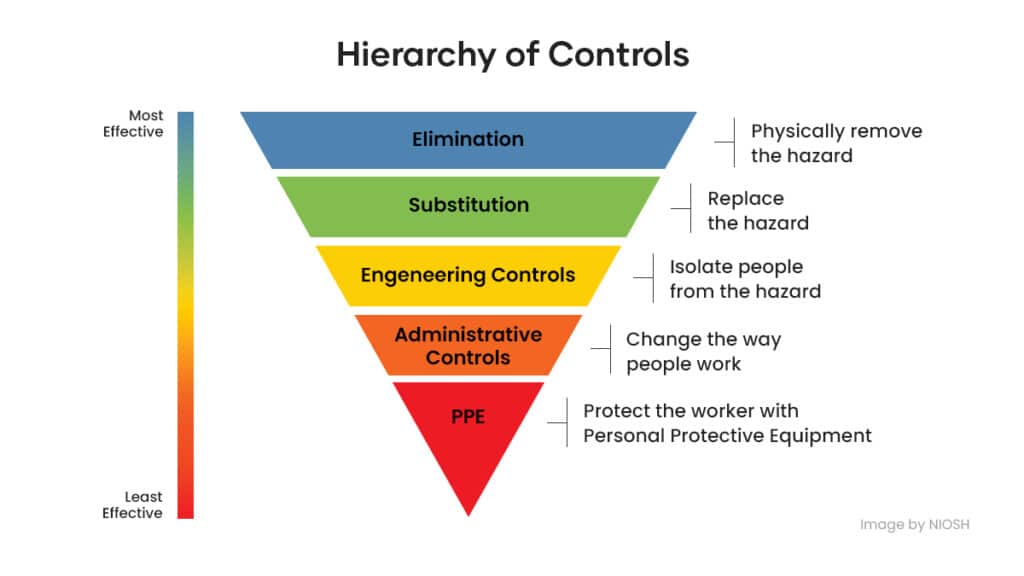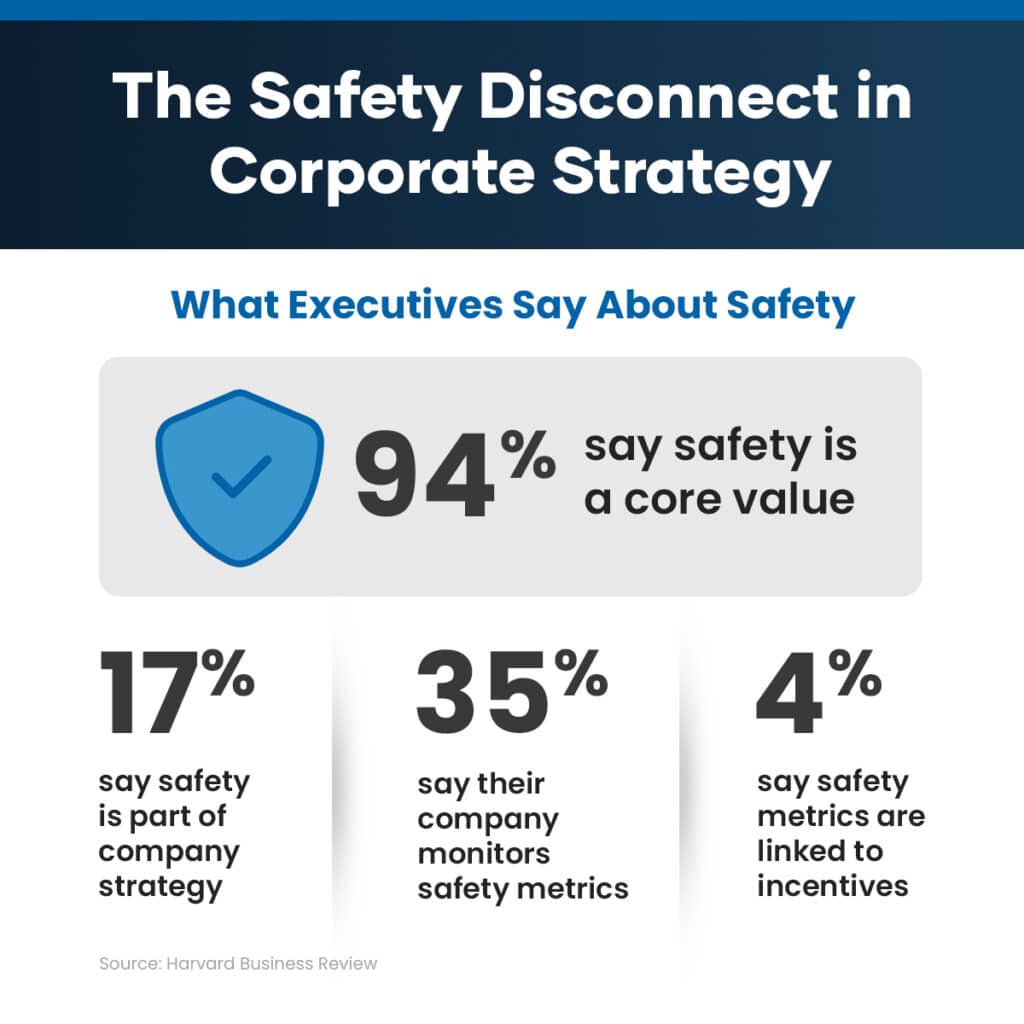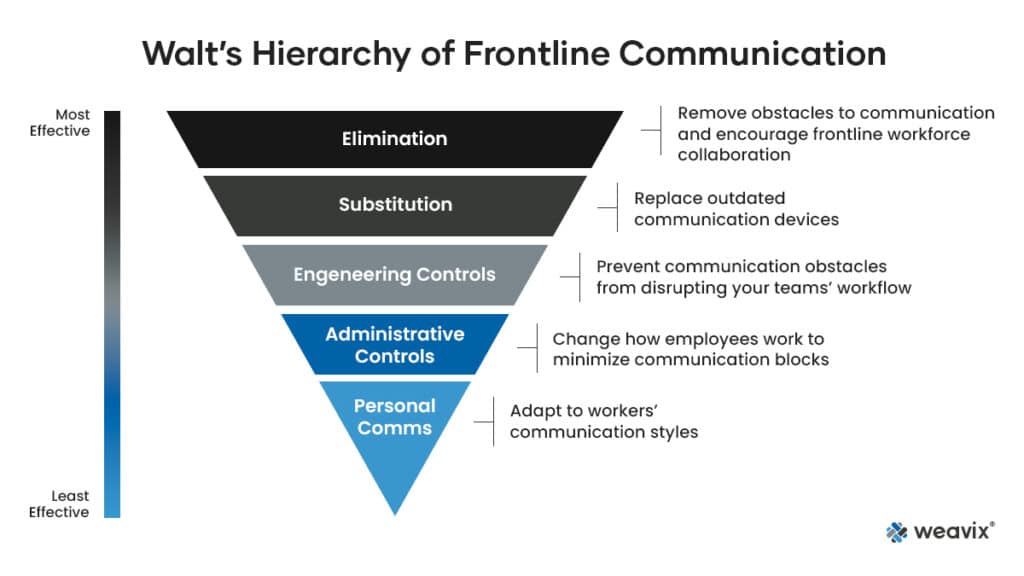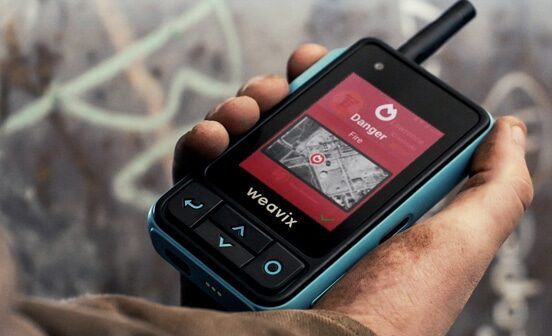All frontline workers and supervisors share the same mantra:
“Safety First”
But how you promote safety on the frontlines will go a long way towards improving safety outcomes. Since we all value “Safety First,” we need to define the best safety practices in the workplace and embrace these procedures at all times.
Key takeaways:
- There are many different ways companies can reduce risks on the frontline. Prioritize different strategies with a Hierarchy of Controls, the foundation for effective workplace safety rules.
- While many companies consider safety to be a necessity to protect workers from harm, safety also drives higher performance. We share several examples of safety practices in the workplace, along with recommendations for your team.
- The Walt® Smart Radio by weavix® promotes good safety practices in the workplace based on the Hierarchy of Frontline Communication, which strengthens enterprise-wide collaboration.
What Constitutes Safety in the Workplace
Safety in the workplace is often viewed as protection from threats of all kinds, but this only scratches the surface. Real safety goes beyond the absence or removal of potential dangers. The most effective workplace safety practices make it possible for employees to perform at their best. This definition encompasses the physical, psychological, and environmental aspects of safety to create a place where everyone can thrive.
The NIOSH Hierarchy of Controls serves as the foundation for all discussions about safety that recognize workers’ autonomy and willingness to collaborate with each other. We must address these safety measures in the workplace before we can discuss methods to support employees’ psychological safety.
The Hierarchy of Controls Highlights the Importance of Safety Procedures in the Workplace

While elimination — physically removing the hazard — is the most effective way to keep workers safe, ideally all types of controls should be employed in concert so your employees’ safety doesn’t hinge on only one method.
Here are the 5 safety rules in the workplace, according to the Hierarchy of Controls:
- Elimination: Companies can often eliminate threats long before workers begin their shifts. For example, companies can purchase less noisy equipment to minimize the risk of hearing damage, and advise employees not to drive during harsh weather conditions.
- Substitution: Which materials do your workers currently use that you can change out for less hazardous alternatives that would produce the same or even improved results? For example, if your team works with different chemicals, you should consider less toxic alternatives. Substitution is one of the best safety practices in any industrial environment.
- Engineering Controls: How can you prevent your workers from getting too close to dangerous areas? Effective engineering controls include proper ventilation, removal of silica dust, and similar safety procedures in the workplace.
- Administrative Controls: These methods seek to change how employees perform their work to minimize safety risks. How much training do you provide your team on proper work processes? What is the minimum number of rest breaks you mandate during strenuous work tasks? Administrative controls like these are examples of good safety practices at work.
- Personal Protective Equipment (PPE): Safety glasses. Reflective vests. Hard helmets. Everyone who works in a manufacturing plant or a similar facility is familiar with PPE. And this is one of the greatest ironies, since PPE on their own – while still important – are one of the least effective safety ideas for the workplace. PPE must be combined with all the other controls to minimize workers’ exposure to danger.
Psychological Safety Rules in the Workplace
Earlier we explained that the most effective safety rules in the workplace are the ones which make it possible for employees to perform at their best and produce their best work. Guidelines like these remove threats to workers’ physical safety. More specifically, as McKinsey revealed, psychological safety is the absence of interpersonal fear.
To break this down in simple terms, this means that if you create a safe workplace where people are willing to speak up and share new ideas, you will create a healthy culture without interpersonal fear.
What does interpersonal fear look like in a manufacturing plant or similar industrial setting?
- Anxiety about speaking up and shutting the line down when you notice something wrong, because your supervisor set high production goals.
- Unease about asking for help with an unfamiliar procedure, since you’re concerned about ridicule or wasting people’s time
- Stress over not speaking the dominant language on-site
Now, imagine what your job site would look like if you minimized the causes of interpersonal fear. In this work environment, workers would be encouraged to ask for help as soon as they run into trouble, because they know every one of their team members “has their back.”
Employees would have no issue stopping the line if it meant preventing costly waste and rework, or if they saw a threat to others’ safety. And workers would feel confident communicating in their preferred language, since their communications would always come through with accurate translations.
One of the best workplace safety tips? Create an environment in which everyone feels comfortable sharing anything related to the team’s working conditions, good or bad. This is the essence of “Safety First” or creating a “Safety Culture,” and it’s the foundation of frontline workforce collaboration.
Keep reading: How enterprise-wide collaboration connects frontline teams
Advantages of Promoting Safety Practices in the Workplace
Isn’t it obvious that safety training in the workplace would lead to fewer accidents, lower costs, and a corresponding rise in employee retention? So, you might be surprised by what Harvard Business Review (HBR) discovered when they surveyed 76 executives from 30 different companies.
Turns out, only a measly 17% of those surveyed said that safety was part of their company strategy! Why the mismatch? When companies only see safety as a cost center, they will routinely underinvest in it. But the truth is, there are many advantages to promoting workplace safety rules and nurturing psychological safety within your organization.

Reduced Accidents
In the article we cited above, HBR also shared findings from their analysis of 32,061 construction sites across New York City. It found that mandatory safety training in the workplace reduced worker injury rates by 15% to 18% and delivered $18 million in annual savings and a 42% return on investment. Here the obvious link between higher safety standards and better safety outcomes is confirmed.
As another workplace safety example, we need only look to Paul O’Neill’s work as Alcoa’s CEO from 1987 to 1999.
In his first speech as Alcoa’s new CEO in October 1987, O’Neill shocked the crowd of shareholders by focusing entirely on the company’s safety record. O’Neill’s speech that day created legions of skeptics, who were all later humbled when Alcoa’s market value ballooned by 9x during O’Neill’s tenure, from $3 billion to over $27 billion. (Insider note: weavix’s founder Kevin Turpin is rather fond of this story, and it has inspired him throughout his leadership journey.)
Cost Savings
Research on Operating and Net Margins collected from NYU Stern School of Business reveal that the average net profit margin across all types of manufacturing companies is 8.2%. When we add this figure into this Occupational Safety and Health Administration OSHA calculator, a single minor injury like a sprain can cost a manufacturing plant close to $64,000 in direct and indirect costs.
Based on data from the Bureau of Labor Statistics, there were roughly 2.8 nonfatal occupational injuries and illnesses per 100 workers in 2023. If just a single minor injury can cost your manufacturing operation close to $64,000, think about how much you could cut costs by implementing the best safety practices in the workplace.
Improved Employee Retention
McKinsey found that Gen Z values physical and psychological safety when considering whether to stay at a manufacturing job or look elsewhere, far more so than other age groups. This represents a shift in employees’ perception of what constitutes safety in the workplace. And it highlights the need to remove all sources of interpersonal fear among your team members to retain highly skilled workers.
So, a growing number of manufacturing employees consider safety first when deciding whether to stay at a job. On top of that, the National Association of Manufacturers found that 65.2% of survey respondents stated that attracting and retaining a qualified workforce was their top challenge. The message is clear: either companies focus on safety, or they won’t be able to find anyone to work for them.
Taken together, general safety rules in the workplace aren’t just a good idea. They’re essential, and they deserve to be an explicit part of your company’s strategy. But how do these guidelines play out on the frontline?
The Hierarchy of Frontline Communication
We’ve already shared many of the benefits of safety training in the workplace, and what these mean for physical and psychological safety. And the common thread tying all these factors together is open communication.
Clear communication is the foundation of every safety training course, safety drill, and indeed every personal interaction throughout your employees’ tenure. It’s essential during their day-to-day work and absolutely critical during emergencies. Because if you can’t communicate your values around safety, how likely is it your team will get the message?
Think back to the Hierarchy of Controls we shared at the beginning of this article. In order to highlight the importance of clear communication on the frontline, we developed our own version, Walt’s Hierarchy of Frontline Communication.

Now, let’s compare the methods companies can use to keep workers safe based on the original Hierarchy of Controls with a few of their corresponding actions in Walt’s Hierarchy of Frontline Communication. Again, keep in mind that these controls are listed in descending order of effectiveness, with Elimination being the most effective at keeping workers safe, removing obstacles to clear communication.
| Controls | Hierarchy of Controls for Safety Hazards | Hierarchy of Frontline Communication |
|---|---|---|
| Elimination | Remove potential threats from the workplace altogether. | Encourage frontline workforce collaboration. Ensure psychological safety and remove sources of interpersonal fear. |
| Substitution | Swap out hazardous materials for less toxic alternatives that would produce the same or better results. This is one of the best safety practices in any industrial environment. | Drop your legacy two-way radios for smart industrial radios, since the latter excel in terms of range, flexibility, and total cost of ownership. |
| Engineering | Prevent your workers from getting too close to dangerous areas. Examples include proper ventilation, removal of silica dust, and similar safety procedures in the workplace. | Provide frontline safety solutions in the form of smart radios to everyone on your team, so they’ll be able to respond quickly during an emergency. |
| Administrative | Change how employees work to minimize safety risks. Examples like proper training and mandated rest breaks are good safety practices at work. | Change how employees work to minimize communication blocks. Let them listen to music, and make it easy for them to log in to their radio with a simple tap from their NFC badge. |
| Personal | PPE must be combined with all the other controls to minimize workers’ exposure to danger. While important, PPE on their own – while still important – are one of the least effective safety ideas for the workplace. | Workers’ personal communication choices include their preferred language and how they share information with smart radios (voice, pictures, or video). Remember, these details are moot unless the other controls are in place. |
Top 5 Workplace Safety Tips
Now that we’ve established parallels between the NIOSH Hierarchy of Controls and Walt’s Hierarchy of Frontline Communication, let’s examine each tier of the latter in greater detail.
1. Establish Clear Communication Channels
This is another way you can stress the need to eliminate obstacles to communication. And this starts with giving people permission to speak up in any situation, good or bad. Safety doesn’t happen in isolation, and your workers need to feel psychologically safe so they can help everyone else on their team stay physically safe. Clear communication creates a better frontline employee experience, and it’s one of the most effective safety ideas for the workplace.
2. Exchange Legacy Radios for a Comprehensive Communication System
If you want to encourage clear communication on the frontlines, you’ll need to substitute your legacy radios for smart industrial radios. That’s because legacy two-way radios are ill-equipped to meet your team’s needs:
- High total cost of ownership (TCO) and long repair times mean many companies only give these radios to a small percentage of their frontline workers. If only a few of your workers have the ability to alert others to safety risks, that’s one of the worst workplace communication barriers.
- Legacy radios’ range limitations limit your workers’ ability to communicate freely. For example, while the risks of confined spaces are well-known, these environments are also notorious for blocking radio signals. What do you say to your legacy radio vendor when dangerous situations like these are the same scenarios where your workers can’t reliably call for help? This is unsustainable.
- Traditional two-way radio systems don’t preserve a record of who sent which messages to others on the team. They don’t tell you how quickly your team members acknowledged mass alerts. And they can’t give you any insights into how to improve your emergency response plan. Legacy radios only transmit voice messages from one person to another. They can’t show you the big picture.
- Finally, legacy radios can’t translate from one language into another. So, it doesn’t matter how strongly you encourage clear communication if you allow language barriers to persist. These communication blocks will prevent your workers from speaking up unless you exchange your legacy radios for devices that offer instant translations.
- The Walt Smart Radio System offers a frontline communication platform that overcomes all the drawbacks of legacy radios. Walt opens up clear communication channels for any situation. Only our smart industrial radios can create the network of accountability you need to promote good safety practices in the workplace.
3. Implement a Mass Notification System
At no time is clear communication more important for your workers’ safety than during an emergency. So, what engineering controls can you implement to make sure all your workers receive emergency notifications as efficiently as possible?
Mass notification systems let you alert all your employees about safety risks before they pose a threat. But mass notifications increase safety only when they support two-way communication between you and all your employees during an emergency. Up until recently, safety alarms were the only option to alert workers to imminent danger. These systems offer limited customizability and context, which means they can’t deliver the most relevant updates to your workers when seconds count.
On the other hand, the Walt Smart Radio System by weavix lets you deliver different types of alerts to specific groups of workers depending on the nature of the threat. This is one of the best workplace safety examples for using targeted communications to keep your workers out of harm’s way.
And once the emergency has passed, how will you use your emergency notification system to improve your safety protocols for future incidents? Walt’s alerting system lets you see how quickly each worker acknowledged the emergency notification, and track how long it took them to reach the muster point.
This is exactly how you promote good safety practices in the workplace: communicate clearly so everyone can escape danger fast, and then use that data to improve your response time when disaster strikes again.
4. Change How Your Employees Work
What administrative controls can you introduce to make communication as safe and easy as possible for all your workers?
With Walt, any worker can pick up any device and instantly log in to stay connected to their teammates at all times. They don’t need to remember any passwords, which means no downtime at the start and end of shifts. All they need to do is tap their NFC badge on the Walt Smart Radio. This tap-and-go authentication will automatically load their profile with all their preset contacts, channels, and preferred language settings.
You can also keep your workers engaged with music for the frontlines. Research from the National Institutes of Health has shown a positive correlation between music in the workplace and job satisfaction and performance.
And for the first time ever, workers can now listen to Walt music by iHeartRadio on the frontlines in manufacturing environments and other industrial settings through their Walt Smart Radios. What makes this music perfect for frontline workers?
- When your employees can listen to music on Walt, they have one more reason to stay connected to their radios and each other throughout their shifts
- Plant managers and other admins can determine maximum music volume levels, permitted roles, and radio content
- Any inbound messages or alerts will automatically pause the music, so your workers will never miss a beat
5. Encourage Each Worker’s Communication Preferences
Every frontline worker has their own individual communication preferences, which don’t suddenly evaporate when employees clock in for their shifts. This reveals another downside of legacy radios, one hiding in plain sight: legacy radios force everyone to use either push-to-talk communications, or nothing.
Didn’t hear a message because you stepped away from your radio? Too bad. Want to send a picture or video to describe a technical issue? Impossible. And if your employees speak a different language, legacy radios won’t help them communicate with anyone else unless they stop what they’re doing so they can find a bilingual co-worker. How do any of these communication blockages promote good safety practices at work?
Walt takes care of all these issues. Walt lets you send voice, image, or video messages with the push of a button through PT3. And workers can set their language preferences in their profile for any one of 20+ common languages and dialects. Whatever one worker says through their Walt, their recipients will receive in their preferred language through AI translation and transcription.
Finally, with Walt, every message sent is preserved in a secure cloud as your unified communication system of record. This makes it much easier to conduct safety audits, and you can then use this data to improve every other aspect of the Hierarchy of Frontline Communication. When all your safety procedures in the workplace reinforce each other, you’ll be better prepared for what’s next.
Implement the Best Safety Practices with the Walt Smart Radio System
Excellent safety outcomes begin with clear, open communication among everyone on your frontline team. And the best safety practices in the workplace start with Walt. The Walt Smart Radio System improves your team’s ability to anticipate and avoid safety risks through the following means:
- With push-to-talk/picture/video (PT3) and AI language translation and transcription for 20+ languages, Walt allows everyone to connect with each other based on their communication preferences.
- Walt creates a system of record of all your communication, so you can see exactly how all your workers respond during every safety incident.
- Unlike legacy radios, Walt creates a network of accountability for everyone on-site.
Follow Walt’s Hierarchy of Frontline Communication and enable your team with the only smart radio built to keep workers safe. Contact us to see how it works.
 Andrew Rhodes
Andrew Rhodes 
